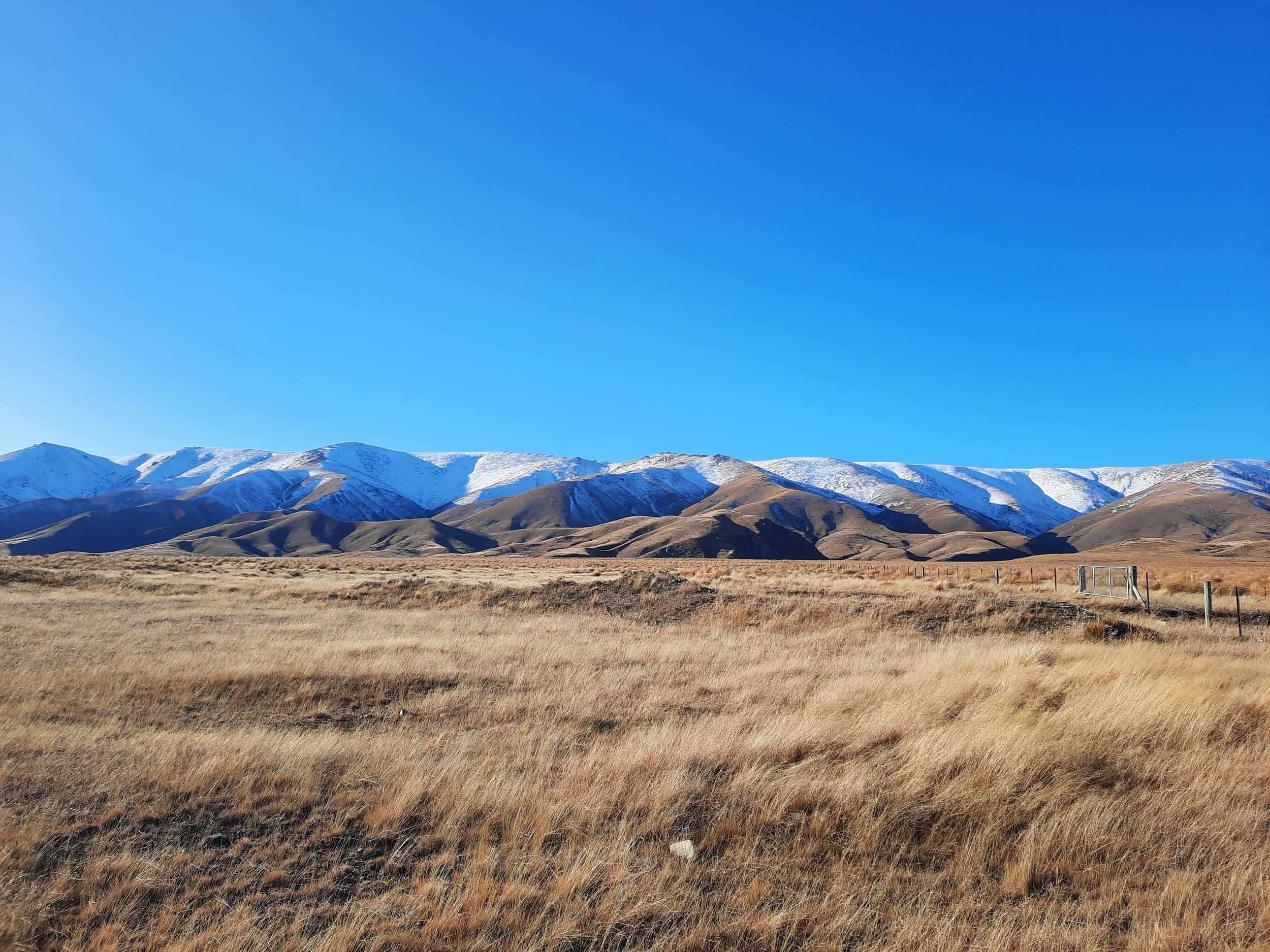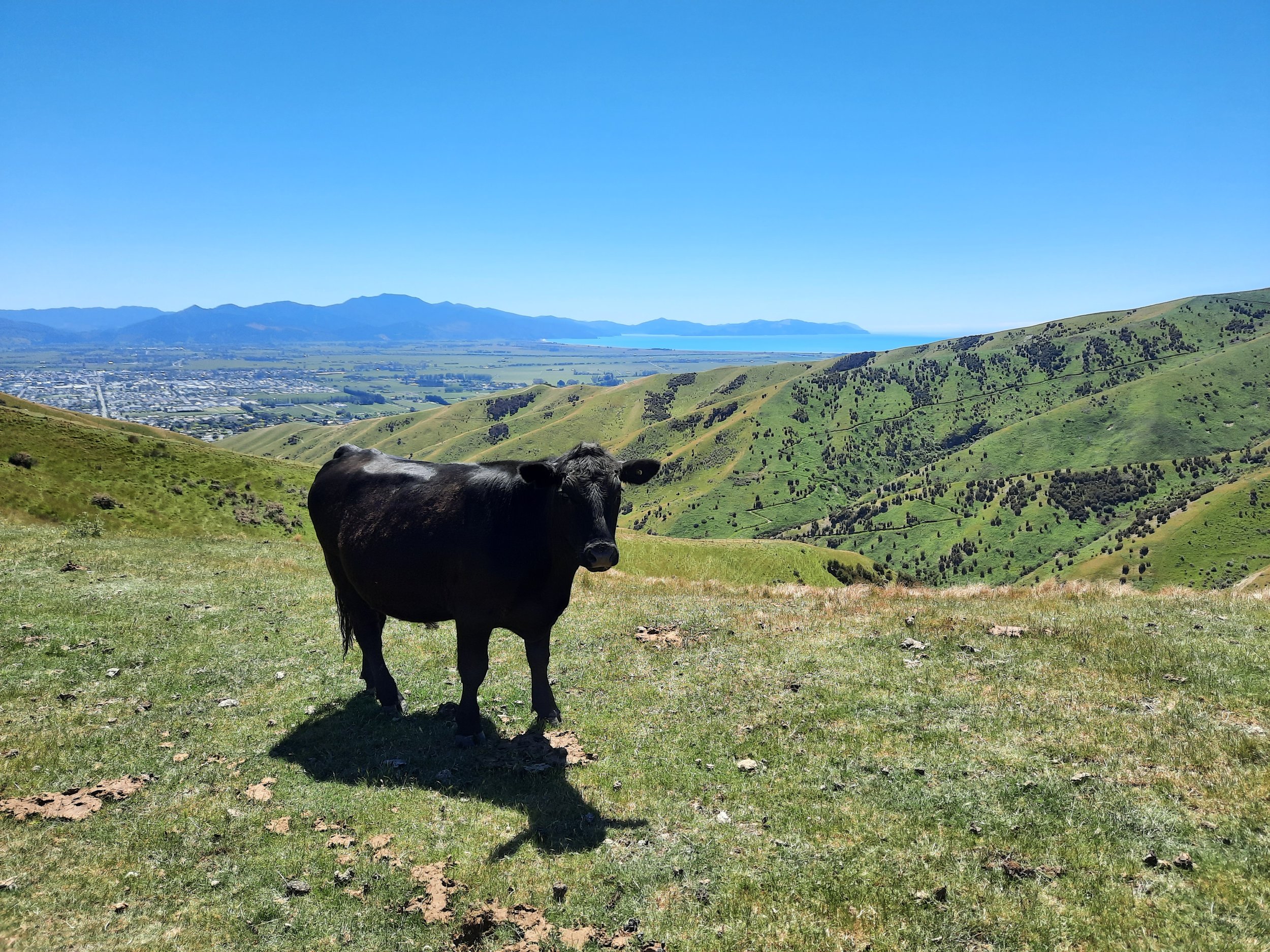Enough of the charming scenery. I prefer the real rural New Zealand.
Māori culture
Some of the South Island’s extensive tussock lands are said to have grown from grasses that fell from a cape worn by Tama, who was searching for his stolen wife. As he ran, flax, tussock and other grasses drifted down and grew up in his wake.
—Polly Stupples, New Zealand Geographic
Wānaka is one of South Island’s best bases for hiking. In this region’s Māori dialect, it means sacred lore. Wanaka (𐀷𐀙𐀏) happens to be the Mycenaean Greek word for king, which is fitting considering Wānaka’s majestic location and its very expensive houses. Perhaps a future hiking blogger will choose Wānaka Wanaka as their moniker.
Visual art
Marian Maguire’s lithographs and etchings (e.g. The Labours of Herakles) are my favorite imaginative combinations of Māori and European (in this case, Greek) motifs.
The most evocative paintings I've seen of hiking-worthy NZ terrain are those by Mike Glover (Facebook), of Canterbury, and Grahame Sydney (Instagram), who is based in the hamlet Cambrians, Central Otago. See my photo of the Hawkdun Range to get an idea of Sydney’s paintings. The film The Power of the Dog also features this scenery.
At least two of my Otago accommodation hosts have been talented artists:
portraitist Ika Willett
scenic photographer Michal Karnik (whose postcards you might find in shops).
I said the real rural New Zealand.
Reading
A few books I've enjoyed about areas of rural NZ:
Miners in the Clouds: A Hundred Years of Scheelite Mining at Glenorchy, by Julia Bradshaw.
On Bookabach.co.nz, you might find a Glenorchy bach (holiday home) now owned by the boy who can be seen posing with his father, a miner, on the bookcover.
John and Charles Enys: Castle Hill Runholders, 1864-1891, by Jenny Abrahamson.
Castle Hill is just one of several high-country sheep stations with a coffee-table book like that dedicated to them. I wonder, are these books meant to turn a profit? Or are they vanity projects, like this blog?
Books I've read about NZ in general:
Perfection.
Motueka Valley, Tasman
Māori Myth and Legend, by A.W. Reed. There's probably a more scholarly alternative to this. But what does scholarship add to myth?
The Penguin History of New Zealand, by Michael King. Not an exciting twentieth century. But no news is usually good news.
A History of Otago, by Erik Olssen. The region went from boom to backwater. This is probably pleasant, from a hiker's perspective, because it means roads and hiking trails without many people to use them. (Not coincidentally, though, a lot of the rural roads remain unpaved.)
His Best Stories, by Witi Ihimaera. A selection of short fiction by one of the most widely-read Māori authors.
Here are some magazine articles on NZ’s various types of public land, and their histories.
My favorite secondhand bookshops in NZ
Auckland:
Hard-to-Find Books (most fun to explore; also, haunted)
Jason Books
Bookmark (nice interior decor)
Wellington:
Pegasus Books (best interior)
Arty Bees
Christchurch:
London Street Bookshop, Lyttelton (only bookshop I’ve visited during a hike)
Steadfast Books
Dunedin:
Hard-to-Find Books
Dead Souls
Pioneers, innovators, and rogues of the NZ backcountry: Some anecdotes
One night Tarewai crept back to the Mamoe settlement at Papanui. The people were seated around a fire, passing Tarewai’s patu hand to hand and retelling their deeds in ambushing the Kāi Tahu people [Tarewai’s people] from Pukekura. In the dark, Tarewai joined the circle, keeping his face concealed. When the patu came to him, he brandished it above his head and called: ‘Nāia te toa o Tarewai, kai a ia anō tōna patu!’ Here is the brave Tarewai, reunited with his patu! Before the shocked Mamoe people could react, he sprinted into the bush…
Maru wrapped himself in a sealskin and lolled about on the spit below the pā like a free meal. The Mamoe people came out unarmed to claim their prize. They were ambushed and killed, and the pā burned.
Nic Low, New Zealand Geographic
[Otago Province Superintendent James Macandrew’s financial] speculations had lost him some 40,000. Gaoled for debt, he promptly declared his own house at Carisbrook a gaol and ordered [gaoler Henry] Monson to imprison him there. Monson complied.
Erik Olssen, A History of Otago
[Illiterate Scotsman James] Mackenzie was discovered with 1,000 sheep from Robert and George Rhodes's Levels station, north of Timaru… Unable to tolerate imprisonment, he escaped at least twice, in May and June 1855, neither escape lasting more than three days. After this he was placed in irons and carefully watched… [Pardoned in 1856,] Mackenzie probably returned to Australia, but nothing certain is known of his later life… Mackenzie's exploits won him the admiration of those on the margins of society. Small would-be farmers wanting their own land or resenting the power of large wealthy landowners could identify with him, as could those who did not fit the mould of genteel Canterbury society.
Cathy Marr, Te Ara
James Mackenzie ended up with a big memorial (the grand Mackenzie Basin named for him) and a small one (a statue of him with his sheepdog, Friday, in Fairlie).
William O'Leary, known as Arawata Bill… resigned as ferryman in 1928 [at age 63], and thereafter devoted most of his life to prospecting the river valley from which his nickname derived. It is possible that his long association with the Arawata stemmed from a practical joke. During an early prospecting expedition there, one of his companions pretended to find a nugget he had previously won on the Shotover. O'Leary refused to believe the nugget had been planted, and remained convinced that the Arawata carried heavy gold… [O’Leary] had made no significant gold finds during his lifetime, but, as he admitted to a friend, his prospecting only rationalised his love for the back country.
Waitomo, King Country, Waikato.
Alwyn Owen, Te Ara
When Fred Miller, a South Island journalist, was laid off by his newspaper [during the Great Depression], he took his family to Central Otago for three years where he panned for gold (and, for part of that time, housed his wife and children in a cave). The motto he coined as a result of those years was ‘Pain is inevitable, misery is optional. Stick a geranium in your hat and be happy.’
Michael King, The Penguin History of New Zealand
[Convicted thief George Wilder] had style and he had flair, growing in popularity when it was said he joined his own search party before disappearing into the bush... During his 172 days of freedom, he generated massive public attention, partly for his politeness - he left apology notes and cleaned up the properties he had broken into.
Tom Hunt, Stuff
Wilder is the only North Islander here.
[A man known as ‘Seagull’] was an old friend—a farmer’s son and a practical kind of guy who once, working on track maintenance in Fiordland during the roar, lured a stag to him by imitating its grunts with a chainsaw.
Derek Grzelewski, New Zealand Geographic
[O]ne must assume that only self-willed individuals would choose to live in the community that appears to be so isolated and exposed to harsh winter climes [of the Manuherikia Valley, Central Otago]. And, sure enough, a community spokesman said the dozen or so households of Cambrians held a meeting and collectively decided they did not want to help the Otago Daily Times with its feature on the tiny settlement.
Hamish MacLean, Otago Daily Times
¯\_(ツ)_/¯
Television classics
A Dog’s Show: sheepdog trials (the only NZ TV show I’ve watched a full episode of, so far)
The Instant Kiwi Attitude: ad promoting the lottery through bungee-jump fishing
Legend: ad discouraging drunk driving - “‘You know I can’t grab your ghost chips.’”
See also: https://falliblepieces.substack.com/p/all-things-new-zealand.
NZ English for travelers, especially speakers of US English
tussock = bunch grass
“[A] tussock is not actually a single group of related plants but a growth habit—a particular arrangement of stems and leaves which forms a tuft of vegetation. The stems, or tillers, from which the leaves sprout are unusually tightly clustered.” (New Zealand Geographic)
Department of Conservation (DOC) = tourism and conservation bureau, like the US National Park Service
the bush = forested areas
bushline = treeline
the backcountry = the great outdoors
tramping = hiking & trekking, with more of an emphasis on multi-day, mostly flat treks than in the US and UK
track = trail
track notes = trail guide
mission = challenging hike/tramp
on a mission
waratah = steel fencing post with a Y-shaped junction (as opposed to a star junction)
from an Australian aboriginal word for a type of flowering shrub
sealed road = paved road
metal/metalled road = gravel road, i.e. a type of unsealed road
from Latin metallum, quarry
the wops / wop-wops = the boonies, i.e. rural areas where you find metalled roads
station = large ranch
run = parcel of pastoral land controlled by a station
runholder = owner/leaseholder
lambing = when ewes give birth in spring, and trampers should avoid sheep
Hiking easements are often closed for lambing. This is an inconvenience, especially in the Wanaka-Hawea-Tarras-Lindis Pass area of Otago. Check DOC hike webpages for closure dates.
fawning = when does give birth in late spring, and trampers should avoid deer
the roar = the red deer rut, late March through April or May (sources differ), when trampers should avoid deer, especially the roaring stags
tussocker/tussocky (historic) = swagman, vagabond, itinerant laborer
“European swaggers were sometimes known as ‘tussockies’ because of their habit of tying the leaves of two tussocks together to form a simple shelter to sleep beneath.” (New Zealand Geographic)
pretty average weather = mediocre or bad weather for hiking, i.e. rainy and maybe windy
bach /bæt͡ʃ/ = holiday home
Before checking out, guests are generally expected to do more cleaning for Bookabach.co.nz baches than for Airbnb holiday homes, even if there is no obvious difference between the types of properties. This is just the norm when booking a bach.
mainland = South Island (the bigger one)
For a brief period starting with a 19th-century gold rush, the mainland also had more people.
ute = pick-up truck
compared to US pick-ups, utes are more likely to be on a car chassis
sump = oil pan (underneath a car)
number plate = license plate
rego = vehicle registration
Waka Kotahi = New Zealand Transport Agency (NZTA), the ones who maintain the roads
kit = gear
“all kitted out”
jandals = flip-flops
munted = irreparably broken
op shop = secondhand shop
(my) shout = treat others to a drink
etiquette hint: “no one will raise their voice!”
tomato sauce = ketchup
bench = kitchen counter
Chur! = Thanks!/Awesome!
Yeah, nah. = [What does this one really mean? I remain puzzled.]
Several water-related terms are typically used in NZ as in the US, rather than as in the UK: creek, branch, fork.



